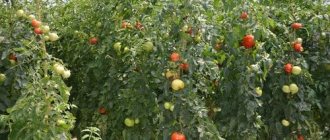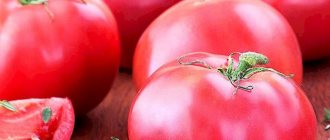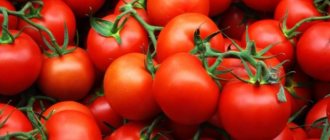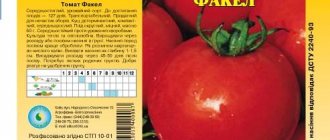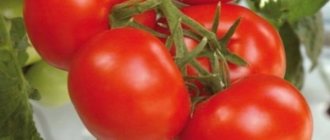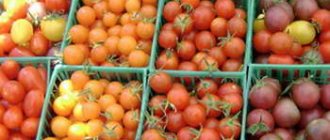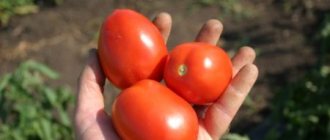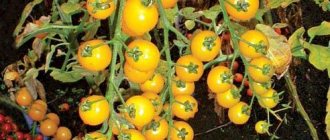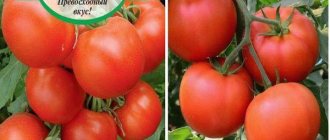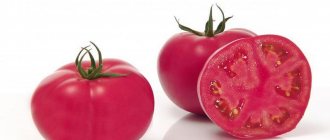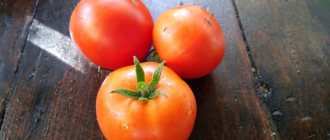The Dutch hybrid Florida F1 produces tomatoes of excellent quality. The high yield and quality of fruits have made it famous among gardeners in all regions of the Russian Federation.
| Height | Landing location | Ripening time | Fruit color | Fruit size | Origin | Fruit shape |
| short | Open ground | Early ripening | Reds | Large | Hybrid | Flat-round |
Altai red tomato: a masterpiece that can grow in unfavorable weather
Tomatoes are tasty and healthy vegetables that any summer resident grows in his garden. In the 21st century, there are many types and varieties of tomatoes, so everyone can choose a variety that will meet all their expectations according to the description.
| Height | Landing location | Ripening time | Fruit color | Fruit size | Origin | Fruit shape |
| Tall | Greenhouse, Open ground | Late ripening | Reds | Large | Hybrid | Flat-round |
Description and characteristics
The tomato is a variety of Altai tomato. There are three of them: orange, pink and red.
The bushes have large dark green leaves. The fruits on the clusters ripen in 4-6 pieces.
On average, the fruits reach 300 grams, but often grow to 500 grams. The tomatoes are juicy, meaty with a slight hint of sourness. The fruits are not prone to cracking.
The bushes can be planted and grown both in open ground and in a greenhouse, however, due to their growth of 150 centimeters, it is recommended to plant them in greenhouses.
Advantages and disadvantages
- High yield
- Excellent taste
- Long-term storage
- Transport resistance
- Resistance to cracking
- Resistance to many diseases
- Tolerating temperature changes
- Long fruiting period
Minuses:
- Needs bush formation
- Needs tying and piping
- Not suitable for preservation
Features of cultivation
We plant the seeds in pots or containers in early April. Towards the end of May, you can transplant the seedlings into the ground. It is recommended to use greenhouses due to the high growth of the bushes.
When replanting, be sure to tie up the plants. This variety provides for the formation of stepsons, so they must be removed in time.
If this procedure is not carried out in time, the fruit yield will noticeably decrease and they will grow small. Stepchildren retract nutrients and moisture.
Use new or well-treated containers - this will help avoid unnecessary illnesses.
Landing
We plant in pots in early April. We check the germination of seeds. Prepare the soil for seedlings - mix garden soil with peat. For seeds to grow, they need a temperature of at least 25 degrees.
For tall varieties, it is recommended to plant in a zigzag pattern, the distance between bushes is approximately 50 centimeters, between rows - 80 centimeters.
Before planting, it is necessary to loosen the soil and prepare holes for seedlings. Add 1 tbsp to each well. spoon of wood ash. Place pegs nearby and tie the tomatoes to them.
Before watering the plants, loosen the soil to allow oxygen to pass through. It is recommended to water as the soil dries, preferably with warm water.
It is necessary to form bushes with 1-2 stems. Don't forget to remove the stepsons. To give more air and light to the plants, it is necessary to remove the lower leaves.
Diseases and pests
The variety is not prone to diseases, but prevention will not hurt. Remove spoiled plants and fruits in a timely manner and maintain crop rotation.
The mole cricket is considered a terrible pest for tomatoes. With the help of large claws, it digs holes one meter deep, but lives closer to the surface. The most popular methods in the fight against mole crickets:
- Installation of fences. Fence your area on all sides with tin plates. They should go down at least 50 centimeters. However, this procedure must be carried out either for prevention purposes, or when the pest has appeared among neighbors.
- Treating holes with kerosene. Mix 0.1 liter of kerosene and 10 liters of water in a bucket. Then pour 1-2 tablespoons into all holes. It is recommended to carry out the procedure at night, in the evening.
- The smell of pine. The easiest way to fight: you need to put a branch of pine needles in each hole. The mole cricket cannot tolerate the pine smell and will have to leave the area.
- Garlic repellent. Also considered a preventive measure. When planting, place a clove of garlic in each hole. The pungent smell will not allow the mole cricket to get close and spoil the plant.
In addition to traditional methods, there are repellers that can be purchased at a pharmacy or garden store.
Walk through the discovered burrows with a shovel in late spring or early summer; if oxygen enters, the eggs will die.
Diseases and insects
Hybrid Florida f1 is resistant to verticillium wilt, fusarium wilt, alternaria blight, gray spot, and tobacco mosaic. But like any other mid-season crops, tomatoes are susceptible to late blight infection.
Signs of the disease:
- gray-brown spots on leaves, stems and tomatoes;
- whitish coating on the back of the leaves;
- fruit deformation.
For prevention, greenhouses are fumigated with sulfur bombs, the soil is disinfected with copper sulfate, the soil is covered with mulch (sawdust, peat, pine needles, hay, agrofibre), and moderate watering is provided.
If the infection could not be prevented, the following drugs will come to the rescue: “Quadris”, “Fitosporin-M”, “Baikal”, “Antrakol”. Manufacturers indicate instructions for use and dosage on the packaging. Treatment frequency: once every two weeks.
Insecticides: Fitoverm, Neoron, Actellik will help get rid of pests (aphids, whiteflies, spider mites).
Folk remedies are no less effective:
- 200 g of garlic arrows per 1 liter of warm water. Leave for seven days in a dark place. Add 50 ml of concentrate to 10 liters of water.
- Pour 100 g of onion peel into 1 liter of water. Leave for 12 hours, use for spraying bushes.
- Pour 100 g of dry yarrow herb into 1 liter of warm water. Let it sit for three days, strain and spray the bushes.
These products are used once a week.
Agricultural technology of tomatoes
Cultivation of the Florida 47 hybrid involves moderate moisture, loosening the soil or mulching with agrofibre, installing a drip irrigation system, and applying organic and mineral fertilizers.
Landing
The place for planting seedlings is chosen to be sunny, without drafts. Planting of seedlings in the ground begins after reaching 10 cm in height, 35-40 days after sowing. The ideal time for transferring to open ground is the second or third ten days of May, when the threat of frost has disappeared. Seedlings are planted in greenhouses when the ground warms up to +16 °C.
The distance between bushes should not exceed 60 cm.
Watering and loosening
Florida tomatoes love moderate watering and do not tolerate waterlogging or stagnation of water in the soil. The optimal level of humidity in the area will be provided by a drip irrigation system.
The soil is covered with black agrofibre to prevent the formation of a hard crust and the growth of weeds. The non-woven mulch covering perfectly allows moisture and air to pass through.
Advice. Instead of agrofibre, you can use straw, peat and sawdust.
There is no need for pinching bushes. The shoots do not interfere with the formation of ovaries and the ripening of fruits. Low-growing bushes do not require tying to supports.
Top dressing
Hybrid Florida needs organic and mineral fertilizers. Alternating several types of fertilizing increases productivity. The root system and the ground part of the bush completely assimilates organic matter, which stimulates the development of the plant and strengthens its defenses.
Stages of fertilizing:
- after transferring the seedlings to a permanent place - organic matter;
- before the formation of flower clusters and during the formation of ovaries - potassium-phosphorus fertilizers;
- during the fruiting process - potassium fertilizing with a small amount of phosphorus and nitrogen.
The interval between procedures is 10 days to avoid oversaturation of plants. The last portion of fertilizer is applied 14 days before the start of tomato harvesting.
Organic fertilizer options:
- Take one part mullein to 5 parts water. Leave for two weeks, then dilute with water 1:2. Used for watering bushes at the root after planting seedlings in the ground, during flowering and fruiting.
- The bucket is filled 2/3 with chopped nettle greens and water is poured to the top. Leave for 14 days and dilute with water for irrigation 1:10, for spraying - 1:20.
- For 10 liters of water, take 2 cups of wood ash, leave for three days, filter and use for watering at the root.
Options for mineral supplements:
- 40 g of potassium sulfate per 10 liters of water. This amount of solution is enough to treat 1 m².
- 20 g of superphosphate per 1 liter of boiling water. The mixture is infused for 24 hours, then the volume is adjusted to 10 liters.
- 10 g of diammofoska (26% potassium and phosphorus, 10% nitrogen) per 10 liters of water. The solution is used to water 1 m² of soil.
- 1 tbsp. l. nitroammophosphate (16% potassium, phosphorus and nitrogen each) per 10 liters of water. Consumption per bush – 500 ml.
Features of cultivation
Florida hybrid is picky about soil composition. It shows the best results when grown in moderately acidic soil with a pH level of 6-6.5, dense and rich in oxygen. To determine the acidity of the soil, litmus papers or special devices with a long probe are used, which can be purchased at gardening stores.
The best crop predecessors are cabbage, onions, and carrots.
Important! Tomatoes need sunlight and moderate humidity
Recommendations for agricultural technology
The tomato shows good results when grown in open ground in temperate climate zones. The originator recommends the seedling method of planting.
To get the best harvest you need:
- water with warm water as needed;
- feed the bushes at least 4-6 times during the growing period;
- regularly loosen the soil;
- weed the ground.
Tomatoes do not require garter or additional support. The variety regulates its growth itself; there is no need to shoot or pinch the top.
Tomato Florida - description and characteristics of the variety
Dutch breeders working at Seminis deliberately bred a hybrid tomato called Florida F1. The specialists' goal was to exclude a hybrid that could be grown en masse. According to the breeders themselves, sympathy has a gene that significantly increases the “keeping quality” of the fruit.
Tomatoes retain their presentation for a long time, making them suitable for large-scale cultivation and transportation. At the same time, the excellent taste of the tomatoes is preserved, as if this is an advantage of the hybrid compared to others intended for cultivation on a large scale.
Let's consider the main characteristics of tomatoes and recommendations for their cultivation.
The full name of these tomatoes sounds like “Florida 47” F1. This hybrid is mid-early. The bushes belong to the determinant type. Approximately 107-114 days pass from the date of germination of seedlings to the ripening of fruits.
Plants have the following characteristics:
- The bushes are low-growing. As a rule, they do not reach a height of more than 0.7 m, but their trunk is quite strong.
- The advantage is the well-developed and powerful root order of the bushes. It can go deep into the ground up to 1.5-2, and sometimes even 2.5 m.
- Since the plant has fairly wide leaves, they slightly shade the fruits. This can also be called an advantage, as ripening tomatoes are protected from aggressive sunlight.
- The plants form brushes through 1 leaf. They bloom very profusely throughout the growing season.
- Each cluster has approximately 4-5 fruits.
The undeniable advantage of the hybrid is not only the good preservation and love of the fruits, but also the high resistance of the plants to weather changes. They suffer from sudden changes in temperature or the intense heat of the sun. Even in these unfavorable conditions, the bush continues to move forward like a giant and brings a good harvest.
In addition, the plants are quite resistant to a number of diseases characteristic of (types of tomatoes. This allows you to reduce the cost of caring for the bushes, and in addition ensures good survival of the bushes throughout the season.
What characteristics do female Florida tomato fruits have:
- They have a flat-round shape, and their surface is slightly ribbed.
- The weight of one Florida tomato is approximately 220-255 g.
- They have a satisfactorily thick skin, which prevents them from cracking. But at the same time the sympathy is smooth.
- When the fruits are fully ripe, they turn bright red.
- They have fleshy, but quite juicy flesh.
The main advantage of the fruits is their ability to maintain an attractive presentation for several months. At the same time, they remain solid and do not deteriorate in any way. Due to this, the hybrid is recommended for cultivation for sale. Fruits do not deteriorate due to mechanical stress, and they can be transported over fairly long distances.
Agricultural technology
Florida is recommended for open ground. You can grow them here throughout the entire season. But, if you just read the reviews of experienced gardeners, you can find out that when growing in the middle zone of the country, it would not be a bad idea to give preference to a greenhouse. In the southern regions, open gesso is also suitable.
Taking into account growing recommendations, sowing seeds may occur from the very beginning to the end of spring.
When germination, it is necessary to maintain the temperature within 21-25 degrees. When the shoots appear, you need to wait about 12 days. After the formation of the first leaf, you can create a pick. During transplantation, experts advise cutting the roots to a third of their length. This is necessary so that the root structure of adult bushes turns out to be fibrous.
1-2 weeks before the intended planting, be sure to take the seedlings out into the air every day. This is necessary so that it hardens, and after planting it is easier for it to take root. On the 35-40th day, we plant the bushes in the ground. But you need to make sure that there is no threat of frost at night.
Whenever choosing a place for tomatoes on a plot, you need to take into account the plants’ devotion to light and average humidity. It is best if onions, early varieties of cabbage or cucumbers were previously grown in this place. As the plants grow, they will most likely need staking.
Fertilizers should be applied during the etiolation period. Both mineral and organic. Otherwise, the bushes do not require careful care. Do not allow the soil to become too wet. Therefore, watering should be moderate.
Agricultural technology
Florida is recommended for open ground. You can grow them here throughout the entire season. But, if you just read the reviews of experienced gardeners, you can find out that when growing in the middle zone of the country, it would not be a bad idea to give preference to a greenhouse. In the southern regions, open gesso is also suitable.
Taking into account growing recommendations, sowing seeds may occur from the very beginning to the end of spring.
When germination, it is necessary to maintain the temperature within 21-25 degrees. When the shoots appear, you need to wait about 12 days. After the formation of the first leaf, you can create a pick. During transplantation, experts advise cutting the roots to a third of their length. This is necessary so that the root structure of adult bushes turns out to be fibrous.
1-2 weeks before the intended planting, be sure to take the seedlings out into the air every day. This is necessary so that it is hardened, and after planting it is easier for it to take root. On the 35-40th day, we plant the bushes in the ground. But you need to make sure that there is no threat of frost at night. Ever choose a place for tomatoes on plot, you need to take into account the plants' devotion to light and average humidity. It is best if onions, early varieties of cabbage or cucumbers were previously grown in this place. When the plants grow up, they will most likely need tying up. For this, you can use trellises or stakes .
Fertilizers should be applied during the etiolation period. Both mineral and organic. Otherwise, the bushes do not require careful care. Do not allow the soil to become too wet. Therefore, watering should be moderate.
Description of the tomato variety Florida F1 and its characteristics
Dutch breeders from the Seminis company developed the hybrid tomato "Florida" F1 specifically for mass production. As they themselves put it: this tomato is endowed with a “keeping quality” gene, which allows the tomatoes to retain their presentation and excellent taste for longer.
Features of the variety
The full name of the tomato is “Florida 47.” F1 is a mid-early hybrid of the determinate type. Full ripening of the fruit occurs after 110-115 days from the moment of germination.
- The bushes are low-growing with a strong stem, rarely growing more than 70 cm in height.
- The powerful root system goes 1.5-2.5 m underground.
- Wide leaves protect fruits well from sunburn.
- Clusters form through the leaf, bloom profusely and set fruit throughout the growing season.
- From 3 to 5 fruits are formed on each brush.
- The tomato is highly resistant to temperature changes, does not bake in the sun and continues to bear fruit in unfavorable weather conditions.
- Another advantage of the Florida tomato is increased immunity to a number of common tomato diseases.
- the shape of the fruit is flat-round, slightly ribbed;
- average weight from 200 to 250 grams;
- the skin is dense and smooth, not prone to cracking;
- When fully ripe, the fruits acquire a bright red color;
- the flesh is fleshy and juicy.
The undeniable advantage of tomatoes is the hardness and presentation of the fruit, which they are able to preserve for 2-3 months. Tomatoes of the Florida F1 variety are extremely resistant to mechanical damage, so they can withstand transportation well, even over long distances.
Agricultural technology
Tomato "Florida" is recommended for growing in open ground throughout the summer-autumn period. But reviews indicate that in central Russia it is better to grow this hybrid in greenhouse conditions.
- Taking into account the peculiarities of cultivation, seeds for seedlings can be sown from the beginning of March until the end of May.
- The ideal temperature for germination is +22-24 degrees.
- 10-12 days after germination, when the seedlings have already formed their first true leaf, it is time to pick. When replanting, it is recommended to shorten the roots of the sprouts by a third, this promotes the formation of a fibrous root system.
- 7-14 days before planting, the sprouts must begin to harden.
- At the age of 35-40 days, young bushes can be planted in open ground, provided that the threat of frost has passed.
- When choosing a place to plant tomatoes, keep in mind that “Florida” needs sunlight and moderate humidity. Ideal predecessors would be cucumbers, early cabbage or onions.
- Planting pattern 60 x 60 cm or 50 x 70 cm.
- As they grow, the bushes may need to be tied to stakes or a trellis. It is also possible to grow it spread out.
- Plants respond well to periodic fertilizing with mineral and organic fertilizers.
- They do not require special care. Watering can be carried out using the irrigation method. Tomatoes can suffer from high humidity, so you need to make sure that the soil is just damp, not wet.
Thanks to its amazing productivity, high marketable and transportable qualities, the Florida hybrid tomato is very popular among farmers.
Tomato Florida
Tomato Florida f1 is a hybrid of determinate type, medium early ripening. This variety is quite productive, produces fruits with amazing taste and excellent transportability. In addition, due to the hardness of the fruits of the Florida f1 tomato, they are stored for quite a long time - up to 2-3 months, which is why gardeners love to grow this variety.
Advantages of a hybrid
Florida 47 f1 tomatoes are designed for growing in open ground. But according to reviews from summer residents, in order to grow this species in cold climates, in these regions it is advisable to plant tomatoes in greenhouse conditions.
After planting the seedlings in the ground, the fruits will ripen in about 75 days, and if you calculate from the germination period of the sprouts, at least 110 days should pass.
The bushes of this type of tomato are quite tall, growing up to 60 cm. Their root system reaches a length of approximately 2.5 m and goes deep into the ground. The leaves of the bushes of this variety are quite wide, which is important during the hot summer - they protect the tomatoes from the scorching rays of the sun and prevent burns.
Advantages and disadvantages of the variety
Parthenocarpic variety of cucumbers: what is it?
To talk on this topic, you need to understand what kind of variety is this, marked with the letter F? Hybrid F1 is a combination of positive properties of one species, but its seeds are obtained after crossing two, three or more varietal forms. To obtain a hybrid plant with the desired varietal qualities, parent plants with the required genes are selected. The resulting hybrid is more productive than its parent varieties. The hybrid is immune to persistent tomato diseases. These are the main advantages.
Attention! A hybrid plant is unable to retain all its positive qualities when re-sown from the seeds of the resulting crop. That is, the advantages and all the positive qualities of Captain F1 are preserved only in the first generation, with a single sowing
In the future, when using seeds of a hybrid variety, the positive qualities decrease. This can be attributed to the shortcomings, and not only of this hybrid.
Tomato Verige F1: variety description
Various varieties of cherry tomatoes are very popular among vegetable growers. The Verige F1 tomato has good reviews; the description and height of the bush, its characteristics and care features are indicated on the package with the seeds.
The manufacturer indicates that this nightshade hybrid is an unpretentious and hardy variety, and also has good immunity to disease. Even a novice gardener can grow miniature, tasty tomatoes. But before you start growing, it’s still worth studying the features of the Verige variety and recommendations for its cultivation.
Main characteristics
Tomato variety Verige F1 belongs to the determinate species. The plant has a small and compact appearance. It reaches a height of no more than 1 m. The strong and powerful trunk does not need additional support; its branches are not spreading, slightly directed upwards. The foliage has a regular shape and is dark green in color. It sparsely fills the entire plant.
The Verige variety belongs to the early ripening species. The first fruits can be harvested 85-90 days after the first sprouting of seedlings. The tomato is suitable for growing in open ground and in greenhouse conditions.
The first ovary of the raceme is formed after 6-7 leaves. On average there are from 8 to 12 tomatoes on one brush. The small fruits have a round and slightly elongated shape, are bright red in color, and two-chambered. The average weight of one tomato is about 20-25 g. The peel of tomatoes is dense, smooth and shiny. Thanks to its properties, the fruits are protected from cracking.
The shelf life of the crop is quite long: from 2 to 4 weeks. The yield of the Verige variety is high; from 1 m² you can harvest from 5 to 7 kg. Hard and dense cherry tomato fruits withstand long-term transportation.
The taste of these tomatoes is excellent. They have juicy and dense pulp, a pronounced tomato taste with a slight sourness. Verige tomatoes have a sugary flavor with fruity notes. The fruits are suitable for universal use. You can use them to make fresh salads, juice, pasta and canned whole.
The Verige tomato variety tolerates drought and heat well. Its dense peel reliably protects the fruit from sunlight, and its powerful root system fully nourishes the bush.
Growing seedlings
Seeds are planted for seedlings in the second half of March. First you need to prepare the seeds for planting. To do this, perform the following steps:
- The planting material is soaked in a weak solution of manganese for 30 minutes, after which the seeds are laid out on a clean sheet of paper and left on the windowsill until completely dry. Manganese allows the seeds to be further protected from fungi and some diseases.
- A growth stimulator solution will speed up the germination process of tomatoes. The seeds are soaked in it for half an hour. Then dry naturally.
Sowing of seeds is carried out in a special container with soil. The soil can be purchased ready-made in the store or you can prepare it yourself. To do this, mix turf soil, peat and sand in equal parts. The soil is well moistened and fluffed up. The seeds are buried 1-1.5 cm into the soil and covered with earth on top.
Watering should be done as needed; it is important to avoid stagnation of moisture and dampness in the container. The greenhouse is covered with film on top and placed in a warm and well-lit place.
The film must be removed from the box every day. This is necessary so that the soil is ventilated and excess moisture evaporates.
As soon as the first 2 leaves appear on the sprouts, begin picking. You can plant seedlings in larger containers or use plastic or peat cups for this.
Gardeners recommend hardening off seedlings before planting in open ground. To do this, you need to take the box with young shoots outside for 1-1.5 hours every day. This can be done if the temperature outside is above zero.
Planting tomatoes
Planting material is planted in open ground when the risk of night frosts is excluded and the temperature does not drop below 10°C.
Before planting, the beds are dug up and fertilizers are added to the soil. The scheme for planting seedlings is 70 by 40, 6-7 plants per 1 m².
After planting, the holes must be mulched with sawdust and watered well with settled water. After some time, it is worth fertilizing with complex fertilizer.
Hybrid form of tomato "Florida F1"
Florida F1 tomatoes are a medium-early ripening hybrid. The fruits ripen 75-78 days after planting the seedlings or 111-115 days after the mass emergence of seedlings. The variety is intended for open ground.
Advantages and disadvantages of the variety
Florida F1 tomatoes have the following advantages:
- Do not need a greenhouse;
- High yield;
- Unpretentiousness;
- Does not require support;
- Does not require stepsoning;
- The fruits are very tasty and smooth;
- Tomatoes tolerate transportation well;
- The harvest is stored for up to 2-3 months;
- Purpose – universal;
- Resistance to common diseases.
The only disadvantage we can highlight is that the hybrid is more suitable for the southern regions of the country. For the middle zone, growing in greenhouse conditions is recommended.
Description
Tomato Florida F1 forms a strong, upright bush with a powerful root system, reaching a depth of 1.5-2.5 meters. The plant is determinate: it reaches a height of 50-60, rarely 100 cm. It does not require pinching or staking. The leaves are wide. Inflorescences are formed through one leaf, or in a row.
Features of cultivation
Florida F1 is chosen for summer-autumn cultivation and long-term storage of fresh fruits. Therefore, the period of planting seeds for seedlings is extended from March to early summer. 35-40 day old bushes are planted in open ground when they have 9-10 leaves and the threat of frost has passed.
Tomatoes prefer soil that is dense but rich in air and moisture. Can be grown in acidic soils. Plants are placed according to a 50x70 or 60x60 pattern in two rows. They are very responsive to the application of organic and mineral fertilizers.
Disease resistance
This variety is resistant to the following diseases:
- Fusarium;
- Vertilosis;
- Alternaria blight;
- Gray spotting.
Fruit characteristics
Florida F1 produces bright red round fruits.
The pulp is dense and has excellent taste. The purpose is universal. The weight is usually 280-300 g. Under poor growing conditions, it decreases to 160-200 g. The breeders who developed this hybrid say that it contains a “keeping quality gene.” Indeed, if the fruits are without damage or fungal diseases, they can be stored for up to 2-3 months. The tomato is transportable, so Florida F1 is one of the best varieties for mass growing tomatoes for sale.
Characteristics and description of the tomato variety Ground Gribovsky
Tomato Ground Gribovsky 1180 was bred by Siberian breeders and included in the State Register. This variety ripens quite early and produces a bountiful harvest. The plant tolerates cold well and practically does not get sick. This variety is suitable for fresh eating; the tomatoes are large with a rich tomato taste.
Details about the variety
The description of the Ground Gribovsky tomato allows you to determine how to properly grow this variety and care for it. The characteristics and description of the variety are described on the package with seeds. The variety was created specifically for cold regions of the country and is resistant to many diseases.
This is an early ripening variety; already in July you can enjoy ripe juicy fruits. The plant has a growing point and usually does not grow above 60 centimeters. Low bushes are good because they do not need to be tied up or pinched. The harvest is always plentiful, the fruits ripen almost simultaneously.
The fruits can weigh up to 150 grams. The shape is round and regular. They are red, juicy and tasty. The pulp is fleshy. Their average size allows them to be preserved entirely. But basically, these tomatoes are grown for fresh eating. Salads made from them in combination with other vegetables are simply incredible. The skin is thin and does not tolerate transportation well.
These tomatoes need to be grown correctly, otherwise mistakes can be made.
Features of cultivation
Tomatoes can be grown in a greenhouse or in open ground in seedlings. First, seedlings are germinated from seeds at home. They are sown in special containers, covered with film, and wait for germination. During germination, tomatoes need to be provided with the right temperature and sufficient light.
When the sprouts already form three leaves, they can be planted in different pots. This is done to speed up their growth. Seedlings periodically need to be fed and the soil loosened. They also need to be ventilated and hardened.
They are sometimes taken out onto the balcony, thus preparing them for planting in the garden.
Only seedlings with strong stems and healthy leaves are planted on the site.
When planting, it is important to maintain the required distance. The land is prepared in advance; it must be fertilized and loosened. Before the fruits appear, the bushes need care in the form of fertilizing, watering, and tillage.
Before the fruits appear, the bushes need care in the form of fertilizing, watering, and tillage.
Gentle care
Ground Gribovsky tomatoes require special care. It is necessary to study all the rules that apply to it. After all, tomatoes bear fruit better if they receive more attention.
This tomato variety loves fertile soil and quality watering.
All this is important to ensure their normal development. Tomatoes need to be watered once a week, generously and well with warm water, which has stood for several days in a barrel. You need to feed with mineral and organic fertilizers several times during the growth of tomatoes.
To ensure that food arrives faster, the soil is loosened once a week. It is also necessary to mulch the soil. So the fruits will not lie on the soil
It is necessary to feed with mineral and organic fertilizers several times during the growth of tomatoes. To ensure that food arrives faster, the soil is loosened once a week. It is also necessary to mulch the soil. This way the fruits will not lie on the soil.
There is no need to tie or pinch this plant.
But it is important to treat the foliage with special solutions against diseases and harmful insects so that they do not overpower vegetable crops
If tomatoes are grown in a greenhouse, then the greenhouse is always ventilated on a hot day by opening the windows and doors. This controls the humidity level and temperature.
Removing weeds is mandatory, as it takes away all the strength and nutrition from the crops. Tomatoes should not be planted in the same place every year, otherwise they will bear fruit poorly.
The Gribovsky tomato variety will be very popular with those who prefer early salad varieties. It is not difficult to grow it, since caring for a tomato is very simple.
In order for tomatoes to produce a bountiful harvest, it is important to study all the requirements for this care. Successful landings! dachamechty.ru
dachamechty.ru
Characteristics of the Rio Grande tomato variety
In the description of the Rio Grande tomato variety, the main indicator is their ability to bear fruit abundantly, even despite unprofessional care. Yields will always be stable. Thanks to this stability, Rio Grande tomatoes manage to receive good reviews even from summer residents growing tomatoes for the first time.
Rio Grande tomato yield
One of the decisive factors in choosing this variety of tomatoes: Rio Grande has high resistance to negative environmental factors, due to which it produces good yields
This is important for those who grow crops on an industrial scale. Up to 10 kg of tomatoes are harvested from a variety bush
In the description of Rio Grande tomatoes, it is also important that they are able to withstand increased soil acidity, too dry or too wet weather, and mistakes in agricultural technology that novice gardeners make.
Area of application of fruits
Rio Grande tomatoes, due to their excellent taste, are suitable for fresh consumption, and they can also be dried or dried. Very often, whole tomatoes are canned - their size allows this to be done without difficulty. They are also suitable for making tomato juice. This variety has good shelf life and transportability characteristics, so their commercial use is possible.
Resistance to diseases and pests
Rio Grande tomatoes are resistant to the main diseases characteristic of the species:
- late blight;
- mosaics;
- gray and white rot.
Despite this, it is better to carry out a number of preventive measures before planting tomatoes. The soil in the greenhouse must be renewed annually and neutralized with a solution of copper sulfate. If seedlings are planted in open ground, then you must adhere to the rules of crop rotation: grow tomatoes in areas where there used to be cabbage, herbs, and legumes. They should not be placed in places where tomatoes or other nightshades were located: peppers, eggplants.
To prevent the plant from being affected by the fungus, it is treated with biological products. To prevent late blight, mulch the soil with humus, ventilate the greenhouse and maintain moderation in watering.
Most often, tomatoes are attacked by pests such as aphids and slugs. You can get rid of insects using insecticides, but only before flowering and the appearance of ovaries. Next, use folk remedies:
- against aphids - soap and water;
- from slugs - an aqueous solution of ammonia.
This will reduce the number of pests on plants and will not cause harm in the future when eating fruits.
Advantages and disadvantages of the variety
The characteristics of the Rio Grande tomato variety have many positive qualities:
- pleasant taste of fruits;
- versatility of use;
- a bush of compact size that does not require gartering or pinching;
- ease of care;
- high productivity;
- ability for long-term storage;
- good transportability;
- possibility of mechanical cleaning.
The disadvantages include the fact that Rio Grande tomatoes are not very juicy. But in other characteristics they are superior to many varieties with fleshy fruits.
Description of tomato from the Elf F1 cherry series and general characteristics of the variety
Growing the Elf F1 tomato will appeal to those who love small-fruited varieties. The beautiful shape and abundance of neat tomatoes on long clusters make the planting very decorative. But the hybrid also has its drawbacks.
General characteristics of the plant
Among the varieties of tomatoes, there is a special category: cherry tomatoes. Sometimes they are called grape tomatoes, implying the small size of the fruits and well-filled clusters. The hybrid variety Elf belongs to this series.
The plant is indeterminate, with unlimited growth. The height of the main stem often exceeds 2 m, especially when grown in a greenhouse. It is recommended to form the bushes into 1-3 stems and tie them to a trellis.
Fruit racemes are multilocular, with numerous evenly developed ovaries. The number of fruits on a cluster can reach 15 pieces. The tomatoes on each bunch ripen together, in greenhouse conditions almost simultaneously. This creates certain convenience when harvesting.
Among the advantages of the variety is the plant’s resistance to fusarium wilt and cladosporiosis. The safety of the crop even in unfavorable conditions is quite high, and with proper care it reaches 100%. The bushes do not require treatment with chemicals and bear fruit even in cool, rainy weather. They are also drought resistant.
Reviews from experienced gardeners indicate that in a greenhouse it is possible to produce 15-20% more tomatoes than when cultivated in open ground. The average yield is about 10 kg per 1 m². Fruiting is extended: from mid or late July to the end of the season.
Like all cherry tomatoes, the variety has a drawback - the abundant formation of stepsons. To get a good harvest, the gardener will have to constantly monitor the growth of side shoots and remove them in time. Overgrown stepsons should not be broken out and thereby damage the main stem. They can be pinched above the first inflorescence. This measure prevents thickening of the bush, but does not injure it.
Features of the fruit
Bushes of the Elf variety produce many spectacular plum-shaped fruits. Tomatoes weighing 15-20 g are collected in elegant, neat clusters consisting of 10-15 fruits of the same size, as can be seen in the photo. The color of ripe tomatoes is intense red, the surface of the tomatoes is smooth and shiny.
The skin of the fruit is strong and thick. Tomatoes of the Elf variety begin to crack only when they are very overripe. The transportability of small tomatoes has the highest characteristics, due not only to the density of the shell, but also to the special properties of the tomato pulp.
The pulp of small berries has increased density. Those who have grown the Elf variety on their plot note that the tomatoes, even when completely ripe, have a slight crunch. At the same time, the tomatoes are quite juicy, but have practically no seed chambers.
The taste qualities are very high. The fruits have a high sugar content (6.8%) and have a pronounced sweet taste. The aroma of Elf tomatoes contains fruity shades. When grown outdoors in cold weather, the taste may change to sweet and sour.
The purpose of tomatoes is universal. Small, dense, beautiful tomatoes look impressive in marinades. They are also tasty fresh: in salads and summer snacks. Cherry tomatoes can be used to decorate sandwiches, dishes and drinks. They are also suitable for processing into lecho. It is not very effective to use small tomatoes as a raw material for juice production.
Agrotechnical requirements
The Elf variety is an early ripening variety (90-95 days). It is recommended to sow seeds for seedlings 50-60 days before transplanting to a permanent location. Sowing is done in boxes, heavily moistening the soil and scattering seed material over it. Cover the seeds with a thin layer of dry soil or sand (up to 0.5 cm). Cover the box with glass and germinate the seeds in a warm place. Shoots will appear within 4-5 days.
Description of the hybrid
An early maturing hybrid of the Dutch selection of the Monsanto company. It was included in the State Register of Russia in 2007. The crop is suitable for cultivation in closed and open soil. The bushes are determinate and do not require pinching or staking. The rhizome is powerful - it goes 2.5 m deep into the ground.
In the photo - hybrid Florida 47 f1.
Distinctive features
The table provides a description of the Florida hybrid.
| Indicators | Characteristic |
| Weight | 180-250 g |
| Form | Flat-round, smooth |
| Coloring | Red |
| Leaves | Medium size, green |
| Type of inflorescences | Intermediate |
| peduncle | With articulation |
| Number of slots | Four to six |
| Pulp | Medium density, juicy |
| Taste | Sweet, pleasant |
| Skin | Dense, does not crack |
| Purpose | Salad hybrid |
| Bush height | 60-70 cm |
| Ripening period | 110-115 days after germination |
| Productivity | 5-6 kg/m² |
| Sustainability | To verticillium, fusarium wilt |
| Transportability | High |
Description and characteristics of the variety
The Florida petite tomato is a low-growing standard plant with a height of 25-30 cm. It has an average number of corrugated light green leaves. The fruits ripen 85-95 days after the first shoots appear. They are collected in large long brushes.
Tomatoes weigh a maximum of 50 g (from the first bunches), but usually less, being cherry tomatoes. They are round and bright red. The taste is sweet and sour, with a dense skin, which some gardeners call hard. Suitable for canning whole fruits, directly on the bunch, pickling, fresh consumption and decorating salads and sandwiches, as well as preparing any dishes.
How to plant?
For early varieties of tomatoes, both seedling and non-seedling methods are suitable. Home growers often grow Florida Petite cherry from seeds without using seedlings.
The seeds are treated with a solution of potassium permanganate and brought to maturity. To grow tomatoes, use 3 liter flower pots.
The soil is taken from the manufacturer or made up of compost, peat and sand. It should be warm and moist. It is recommended to pour boiling water or Fitosporin solution over the soil mixture.
The soil is compacted and sprinkled with ash. Place 2 seeds in each pot at a distance of 2 cm from each other. Subsequently, the weaker sprout is removed.
After sowing, the pot is covered with film; seeds need high humidity. The film is lifted daily to ventilate the soil. For the development of seedlings, a temperature of 20-23 C is maintained. Seedlings are expected on the 7th day. For young shoots, a certain temperature regime is organized.
Florida Petite tomatoes can be sowed directly in the garden plot. Typically, seedlings are planted when the soil warms up to 12-15 C. They are not treated with an antiseptic and are not brought to maturity.
More on the topic: How to get rid of blossom end rot in tomatoes?
The seeds are planted dry, but in moist soil. Holes are prepared for seedlings. After sowing, they are covered with film and insulation. The covering material is regularly removed to allow ventilation.
Another method of growing without seedlings involves sowing tomatoes in a greenhouse. An area for seedlings is set aside in the garden bed. Planting is carried out when the soil warms up to 10-12 C.
View this post on Instagram
Publication from SAD | VEGETABLE GARDEN | FLOWERS (@olga__tvardovskaya)
The area is covered with insulation. The seedlings are not watered or given additional light. They do not need to withstand a certain temperature. Shoots appear every month. Subsequently, the seedlings are transplanted to an open area or to a greenhouse.
Gardeners note that when growing tomatoes without seedlings, the harvest will be later, but the plants have increased immunity. Metabolic processes in tissues are accelerated.
Caring for tomatoes comes down to regular loosening of the soil and watering. Gardeners have more time for other garden crops.
The seedling method of growing Florida Petite is used to obtain an early harvest. For the normal development of seedlings, a certain microclimate is necessary:
- seeds ripen at a temperature of 23 C;
- when seedlings appear, the temperature in the greenhouse is reduced to 16 C. A fluorescent lamp is installed, which is not turned off for 24 hours;
- cotyledons emerge within 5 days; leaves appear, the stem grows up to 2 cm. At this time, daylight hours begin to shorten. The lamp is turned off at night for 6 hours. During daylight hours, the temperature is raised to 19-20 C;
- within a month, the day is reduced to 12 hours. The temperature remains the same;
- at the stage of 2 true leaves, the tomatoes are picked and planted;
- Before planting in the ground, seedlings are hardened off.
The seedlings must be watered with warm water. To reduce the risk of developing “black leg”, “Fitosporin” is added to the water. If possible, the soil is loosened. Fertilizing is introduced if seedlings develop pathologies. Gardeners claim that the Florida Petite variety is prone to fattening.
